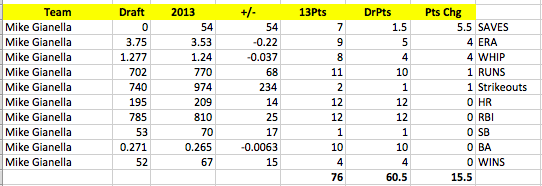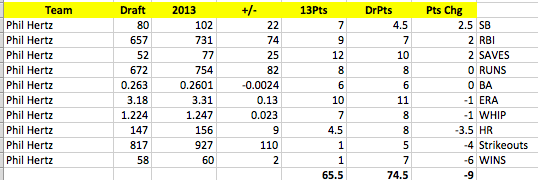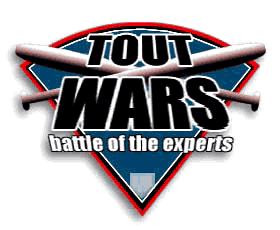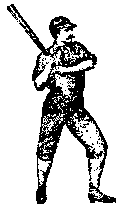Slicing the Hypothetical Standings Another Way.
Looking at one league and drawing conclusions is obviously fraught with issues. An N=1 is inherently unreliable as evidence, but digging deep into the stories in one league can help us identify issues that deserve further exploration.
For instance, at the end of Part 2 I noted that Tristan Cockcroft and Mike Gianella had spent the least on pitching in Tout NL last year and finished first and second, but that was mistaken. Phil Hertz spent more than Gianella and less than Cockcroft, and was the third biggest loser during the season in terms of standings points.
Clearly, spending less on pitching isn’t a surefire winning strategy.
The Story of Mike and Phil
In the auction Mike Gianella spent $34 on pitching. Just 13 percent!
He spent $18 on Mat Latos, $7 on Matt Garza and $3 on Andrew Cashner. The remaining six pitchers, including shot-in-the-dark closers Brandon Lyon and Johnny Venters, were $1 apiece. He scored big wins in Cashner and the $1 Travis Wood, and picked up Edward Mujica for 3 FAAB before Mujica became closer.
The Mujica score, along with a mid-August deal for Brad Ziegler and a late August deal of Latos for Craig Kimbrel, turned zero auction-day saves into seven points. The addition of the closers, plus other less dramatic moves, meant that Mike gained 14.5 pitching points without losing a single hitting point. In fact, he added a point on offense in Runs Scored.
Phil spent $53 for pitching, a massive 20 percent of his budget, and two-thirds less than the average team.
For his money he bought 52 saves, thanks to Mark Melancon ($2) and Jason Grilli ($14). He also spent $14 on Jonathan Niese, $9 on Wandy Rodriguez, and $8 on Julio Teheran. He also scored with cheapies Gerrit Cole ($2) and Nathan Eovaldi ($1), which was good because Niese was a bust and got hurt and Rodriguez got hurt.
Despite the good fortune with Cole and Eovaldi and his relievers, Hertz knew he needed pitching and he brilliantly traded Ike Davis for Jeff Samarzdjia and Todd Helton in early May, but it wasn’t enough.
At midseason, for the second year in a row, Phil blew his pitching staff up. In 2012 he climbed from ninth to second after trading off all his starters, but he didn’t not fare as well last year. He wrote about the whole process here at USA Today.
It turns out Phil’s problem wasn’t really how little he spent on pitching. Phil’s problem was that he bought too little hitting given all the money he spent on it.
While Gianella bought 45 hitting points on draft day (including only one in SB), Hertz bought 33 (of 60).
Gianella bought only 15 pitching points, while Hertz bought 41!
It feels like Phil should have been in the driver’s seat, but Mike had two key advantages. His big deficits categorywise were in Steals and Saves. Rather than having to scramble for quality at bats to fix his hitting, he could focus on finding a closer (Mujica to his ears) and speedsters to augment Hanley Ramirez’s resurgence.
It turned out that the steals weren’t out there, but the saves certainly were.
It wasn’t inevitable that he would succeed, but he did.
Similarly, what worked marvelously for Hertz in 2012 came a cropper last year.
The important thing with this close look is to recognize the dynamics in play. You’re in the best position when you’re trading off something that is useless to you for something useful. It’s that easy.
Here is a link to the Tout Wars 2013 Transactions Page. You can use it to unwind what teams did to gain or lose points in the course of last year.
You’ll find a Google sheet with all the standings data here.
Have fun.





You must be logged in to post a comment.